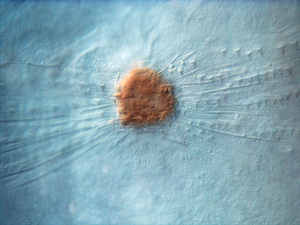Have you been hurting your patients with lasers, derma rollers or mesotherapy to initiate a wound healing response that promotes collagen synthesis and anti-ageing? I have blogged about a new laser technology from Philips before. But soon you may be able to initiate the same response without causing any injury at all. No, I am not going back to peptides again.
 |
| A syncytium forms after wounding the Drosophila epithelium. (Photo credit: Wikipedia) |
Many of the breakthroughs in clinical medicine is inspired by basic research and cosmetic dermatology is no exception. Scientists from University of California have recently published their findings on wound repair in Drosophila or the ubiquitous fruit fly and found some new genes involved in the process.[1] More than the list of new genes they have unearthed, the novel methodology they have employed in their study is of relevance in cosmetic dermatology in spite of the huge difference between the fruit fly and human fly.
The researchers have found that the serine protease trypsin is sufficient to induce a striking global epidermal wound response without inflicting cell death or compromising the integrity of the epithelial barrier and this could be applicable to humans as well. This “woundless wound healing cascade” could have many applications in cosmetic dermatology. Another curious finding was the absence of wound site melanization in trypsin wounded embryos while melanisation was common after puncture wounds. Though the primary focus of the paper was not melanisation and the authors have not discussed it much, this could well realise our dream of ‘controlled injury without the risk of post inflammatory hyperpigmentation’!
References:
1. Patterson, Rachel A et al. “Serine Proteolytic Pathway Activation Reveals an Expanded Ensemble of Wound Response Genes in Drosophila.” PLOS ONE 8.4 (2013): e61773.

- Machine learning-based BOTOX API - April 11, 2023
- Skinmesh: Machine learning for facial analysis - November 10, 2020
- Free Dermatology EMR for Machine Learning and Artificial Intelligence - January 2, 2020




Leave a Reply